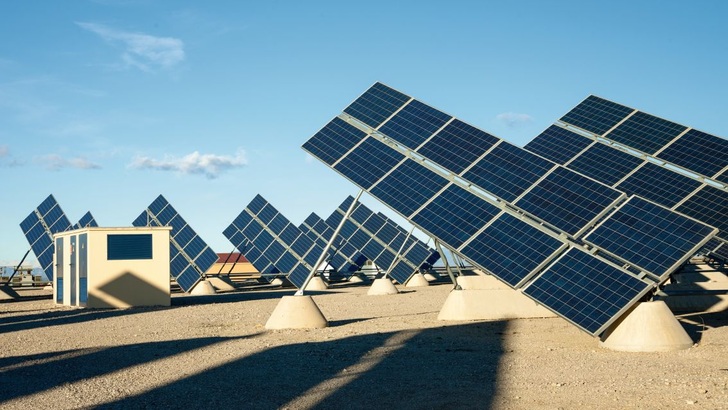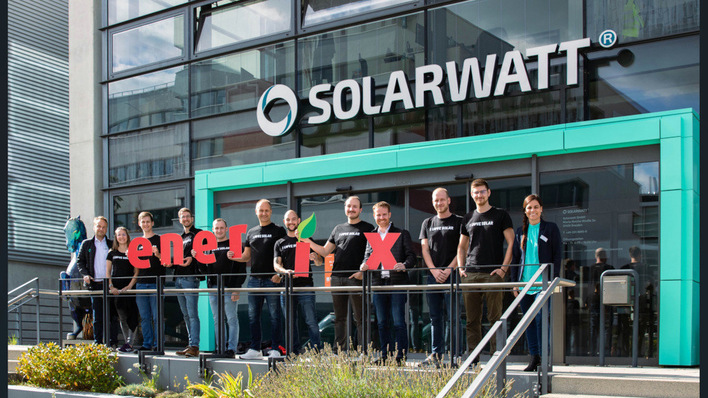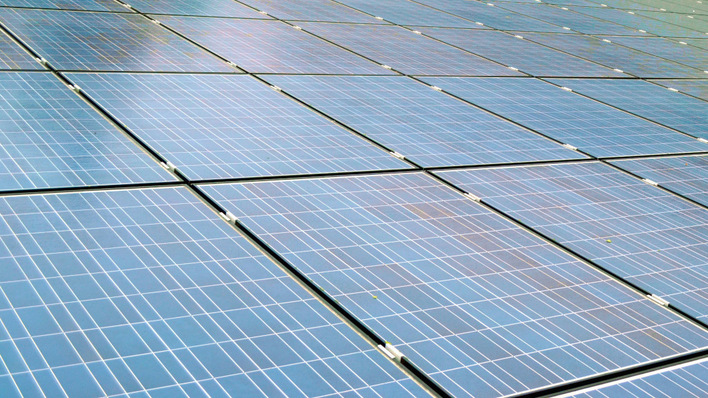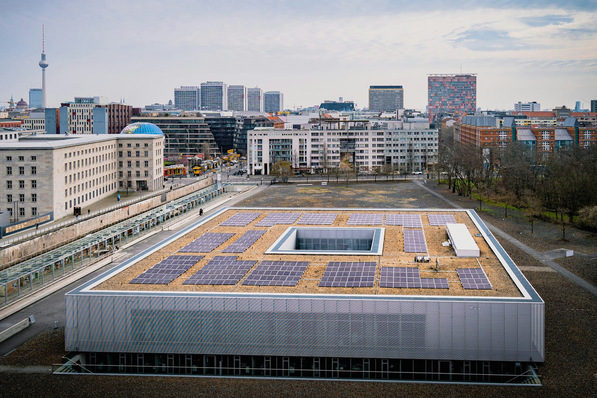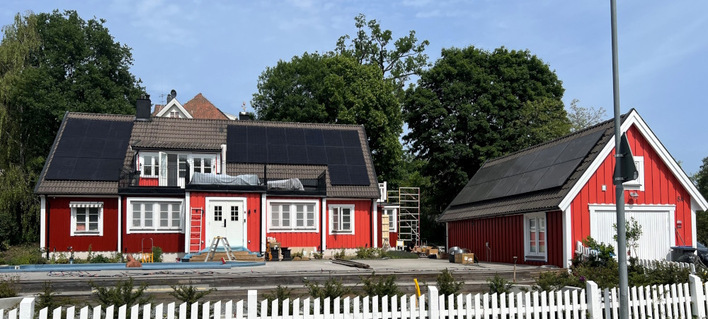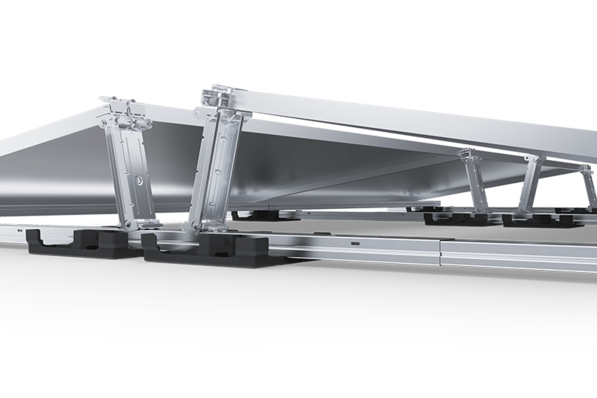Tracking systems are available as uni- or biaxial systems. One axis tilts horizontally, thereby pointing the solar panel due east at sunrise and then following the sun westwards during the day. This horizontal movement follows the sun’s hour angle (azimuth). The other axis rotates in a vertical direction and follows the sun’s elevation, i.e. takes account of how high it is in the sky.
By tracking azimuth and elevation, the panel can be pointed at any point in the sky and thus generate the highest possible energy yields. However, the mechanics of a biaxial system have proved to be much more complicated than for the uniaxial version.
From an economical perspective, it is important to not only consider the costs for the mechanism and the control system, but also the running costs for maintenance. Because these increase the overall costs, they have to be contrasted with the expected additional yields from such an installation. The following is just a comparison of uniaxial tracking versus non-tracking arrays.
Mechanically coupling the axes of rotation
In solar parks with simple, uniaxial tracking, the panels are mounted on a carrier system with a rotary axis. In this way they can be moved horizontally. By connecting several carrier systems with a rotary axis via a push rod, large areas with movable modules are created. The process thus mechanically couples several rotary axes, which simultaneously reduces the number of motors required.
The single-axis horizontal tracking system is moved in such a way that the solar panels face east in the morning. In the course of the day they follow the sun's angle of elevation. This method allows more sunlight to fall on the panels than with non-tracking systems. The solar panels therefore have a larger amount of energy available for electricity generation. This is illustrated by the comparison of the yield curves of a tracking PV system with a fixed south-facing PV system shown in the figures.
The curve of the tracking system does not only show a significantly higher yield. It also shows that energy is generated in the morning and evening. Especially at low angles of elevation, panels mounted one behind the other are shaded. This problem can also be solved through tracking by levelling the panels in such a way that they do not create shade. This process is called backtracking.
Determining the ideal angle of incidence
Due to the long service life of solar systems, which are designed to operate for 20 years and more, the tracking systems must be robust. In addition, users want easy operation, calibration and diagnostics for the solution. Each system consists of mechanics and the electronics responsible for tracking.
For the application of a system as described above, an industrial control system can be used, which has already been successfully introduced in other industries such as the automotive industry. Phoenix Contact provides ILC 1x1 small controllers from the Inline product range. In combination with prefabricated functional blocks, such as those available in the Solarworx software library, complex systems can be implemented quickly and easily.
The algorithm according to NREL (National Renewable Energy Laboratory), for example, is used to calculate the position of the sun in order to determine the ideal angle of incidence with a high degree of accuracy. The NREL algorithm not only uses the current time, date and position, but also takes into account atmospheric values that can distort the sun's rays. An inclination of the plane of the carrier system as well as the rotation along the north-south axis also influence the energy yield. When calculating the best possible angle of incidence, they must also be taken into account.
Compensate for the inaccuracy of the electronics
While the data on rotation, inclination and GPS coordinates do not change, time synchronisation must be carried out at cyclic intervals in order to compensate for the inaccuracy of the electronics. These factors can be used to determine the ideal angle of inclination. However, this is not the angle that the solar panels have to be adjusted to. The length of the panels and the spacing between the rows must be known to prevent shading of the rows at the back. A backtracking algorithm can then be used to calculate the angle of inclination to be used at start-up.
Web-based configuration and diagnostics
When using tracking systems, further requirements have to be considered. This includes the monitoring of wind speed. As soon as the current value exceeds the maximum wind speed that the modules and carrier systems may be exposed to, they must move out of the wind into a safe position. This prevents excessive wind loads from damaging the solar panels and the tracking system.
Manual requirements – such as moving the panels via a control panel or moving to certain positions for cleaning or maintenance – are additional functions offered by all tracking systems. Taking defined priorities into account – such as wind, manual operation or tracking – the set position of the solar panels is transferred to the drive unit – for example a Contactron motor controller from Phoenix Contact – which then moves the units.
Achieve a high degree of system accuracy
In order to achieve a high degree of system accuracy, the position of the axis must be calculated. Measurement systems that generate the position even immediately after an interruption in voltage are suitable for this purpose. Precision potentiometers or tilt sensors have been proven as sensors.
The tilt sensor measures the angle of the solar panels without contact and without interfering with the mechanics. Direct measurement allows the position of the panel to be determined immediately. Referencing is therefore no longer necessary. Due to their modular design, the ILC 1x1 mini controllers from Phoenix Contact can be used as a master unit that controls additional drive units (slaves). A web server integrated in the ILC 1x1 enables configuration and diagnostics of the tracking system. By supporting communication protocols such as Modbus TCP or OPC UA, it is easier to integrate the system into the higher-level visualisation solutions of a solar park.
Learning from other industries
Small controllers that have already stood out in other industries lend themselves to the tracking of solar panels. In combination with special functional blocks, such as those provided by Phoenix Contact in the Solarworx library for the calculation of solar position, backtracking and time synchronization, they help the user to implement tracking systems. This ensures that the solar panels are always optimally aligned to the sun and deliver maximum energy yield.
The author is Erwin Breukelman, Senior Project Manager for VMM Energy Power Generation Solar at Phoenix Contact Electronics in Bad Pyrmont, Germany.
Keep up with innovation in PV! Watch our pv Guided Tours at The Smarter E Europe in Munich:
https://www.pveurope.eu/Videos/pv-Guided-Tours-videos-2018
Stay informed, get our newsletter twice a week.
Register here: https://www.pveurope.eu/Newsletter
Read more about solar modules.
Read more about solar mounting systems.
Read more about solar energy storage.

